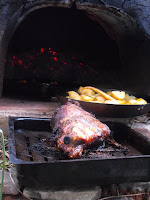
Every project has points where decisions need to be made. Having to use local materials can require a bit of improvisation and it is hard to avoid tinkering a bit with someone else's plans! This oven has a number of features that differ from the Te Radar version. Some worked but not all of them!
I was concerned that cutting out the oven door after building the oven could turn out to be a total disaster so I tried something a little different. I needed a former.Three-ply sheets are thin, flexible and cheap. I used strips of this material to define both the foundation and also the interior of the oven (the base of the sand dome). The former for the oven entrance needed a very tight curve bent into the ply. To get the greater flexibility I put a strip of 3ply into a bath of hot water for a few minutes. Bending the curve was then very easy and I secured it in place with a loop of string until it dried out.
Inserting ordinary ceramic tiles into the base of the oven did not work out at all. The intense heat cracked and shattered these tiles. Terracotta tiles are much thicker and would have worked fine.
Not all clays are created equal, colour and consistency vary. All clays will shrink as they lose moisture and some crumble more than others. It is worth a few experiments to find a suitable and locally abundant clay. Adding one part of cement to eight parts clay, according to a local guru, will help to consolidate the clay. As the clay dries out the shrinkage can cause cracking, particularly as the sand dome will prevent the oven shrinking as a single unit. Keeping it moist in between building stages should minimise cracking if you use clay without cement.
The oven has three clay layers. The first is to store heat, the second thicker layer is an insulation layer to reduce heat loss. Both the second and third layers incorporate plant material for insulation and consolidation purposes. All the references say that straw is the ideal material for the middle layer. Since this isn't available in Tuateawa an alternative is needed. We found that chopped up dead cabbage tree leaves were a reasonable substitute and also the finer parts of nikau fronds. Dead kikuyu is also a possibility but you would need to spray a patch a month or so in advance. The outer protective layer needs finer plant material. Traditionally this has been pre-processed by a cow! Shredded or torn up newspaper, soaked for several days in advance, is sometimes used. Mixing it with the clay might be difficult. You can use a concrete mixer for this and all the previous mixing but it does seem a bit high tech. and could present it's own difficulties.
The chimney hole needs a former. I used a large can with both ends removed.
It takes more than a single firing to reach peak efficiency with the oven. A lot of energy is used up initially just drying the oven out. Some build a shelter over the oven to keep it dry but this seems a bit difficult in a region where horizontal rain is not unusual. A tarp works quite well and stops the oven returning to it's constituent parts!
Te Radar suggests raking out all the embers before attempting to cook. Pushing the embers to the back is safer and works well. A spark arrester of crumpled up chicken wire placed in the chimney is also effective.
Cooking with the oven is a skill that is gradually acquired. Initially the heat is eyebrow scorchingly intense. It moderates over a number of hours so things can be cooked sequentially.The major difference from any other oven is that it cooks largely by radiation and the most intense heat comes from above. A sheet of silver foil placed over food is essential in preventing food becoming a bit charred. Knowing this it is possible to produce incredibly flavoured food. Roast pork with perfect crackling and pizzas the equal of any Italian pizzeria!














.JPG)






.JPG)

